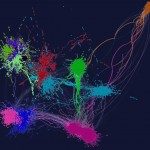Lien vers Pubmed [PMID] – 1574125
Nature 1992 May;357(6373):38-46
The entire DNA sequence of chromosome III of the yeast Saccharomyces cerevisiae has been determined. This is the first complete sequence analysis of an entire chromosome from any organism. The 315-kilobase sequence reveals 182 open reading frames for proteins longer than 100 amino acids, of which 37 correspond to known genes and 29 more show some similarity to sequences in databases. Of 55 new open reading frames analysed by gene disruption, three are essential genes; of 42 non-essential genes that were tested, 14 show some discernible effect on phenotype and the remaining 28 have no overt function.

